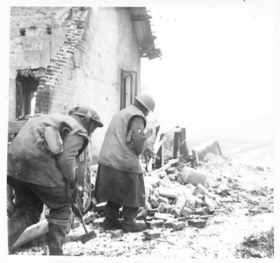Battle of Chongjin: Difference between revisions
(Created page with "{{Template:WIP}}{{Infobox military conflict | conflict = Battle of Chongjin | partof = the Asianna and the Pacific Campaign of the Second Europan War | image = 280px | caption = Troops of the Princess Raphtalia's Jutlandish Light Infantry moving around the Ruins of Chongjin following a heavy barrage, 15 December 1944 | date = 1 December - 15 December 1944 | place = Joyonghea, North Asianna | result = Allied victory; *...") |
(No difference)
|
Revision as of 02:36, 4 June 2024
This article is incomplete because it is pending further input from participants, or it is a work-in-progress by one author. Please comment on this article's talk page to share your input, comments and questions. Note: To contribute to this article, you may need to seek help from the author(s) of this page. |
| Battle of Chongjin | |||||||
|---|---|---|---|---|---|---|---|
| Part of the Asianna and the Pacific Campaign of the Second Europan War | |||||||
 Troops of the Princess Raphtalia's Jutlandish Light Infantry moving around the Ruins of Chongjin following a heavy barrage, 15 December 1944 | |||||||
| |||||||
| Belligerents | |||||||
|
| |||||||
| Commanders and leaders | |||||||
| Strength | |||||||
|
70,000 men 4 armoured brigades 120 artillery 200 planes |
3 Infantry Divisions 5 Militia Brigades at least 200 tanks 50 artillery pieces | ||||||
| Casualties and losses | |||||||
|
1,256 wounded or died at least 40 tanks |
5,254 wounded or died 10,000 died of disease 20,000 surrendered at least 76 tanks 39 artillery pieces | ||||||
The Battle of Chongjin (1 December - 15 November 1944) was a battle that took place around the Northern Hamyong Province. Following Operation Needle Stack, the Hamyong Province was isolated from the rest of Joyonghea and was the last Eastern province that the Imperials controlled. General Harry Kurosawa subsequently advanced along its border with Churuongchandat until in 2 December, when the province was effectively cut-off. Marshal Hồ Danh Sĩ Quốc was determined to halt and attempt to retake the province from the Allies. But Kurosawa's pressure on the Imperials was too strong to the point that many Imperial Generals, including General Olav Timasheff insisted on attempting to resupply the province by air until they can find a way to break Kurosawa's offensive but this breakthrough would never materialise.
In 3 December, Marshal Ho ordered General Quách Kim Long to make a stand in the province and attempt to delay the Allies enough for him to throw a counteroffensive. The latter had been advised by his staff to pull out of the Hamyong countryside and make a stand at Chongjin, which had been a Joyonghean fortress that was built in the 1500s. The Imperials took advantage of the strong defenses that the old fortress offered and were able to repulse several skirmishes around the area. Kurosawa needed Chongjin secured before 20 December and subsequently requested General Okita Hanamura to dispatch General Albert Crocker and a handful of divisions to break the stalemate. Crocker's forces arrived by 9 December and Lucian forces subsequently stormed the defences, breaking through the defences by dusk. Brigadier Murasame Susaya then ordered the Rubrumians and Jutlandish forces to storm the provincial capital. Crocker moved further north to link up with Kurosawa's rear and cut-off the Imperials from any chance of escape. By this time, the winter was at its coldest as temperatures plummeted to -10°C. The defenders suffered from many diseases but despite it Marshal Ho consistently ordered the Chongjin garrison to stand and fight to the last man if no choice was available. By 14 December, the defenders continued to suffer heavy casualties and munitions started to run out. Tanks and APCs also had run out of shells. By the early morning of 15 December, General Quách defied his orders and surrendered the entire garrison to the Allies.
The surrender reached Marshal Ho, who was infuriated, now that Kurosawa could focus on breaking through the border defenses. The Chongjin Fortress' fall was seen by many in Joyonghea as a total liberation of one of the most ancient cities in the country. Following the surrender, Susaya marched further north and contributed heavily to the 26 December push into Churuongchandat, finally breaching the defenses and breaking through the border defenses.